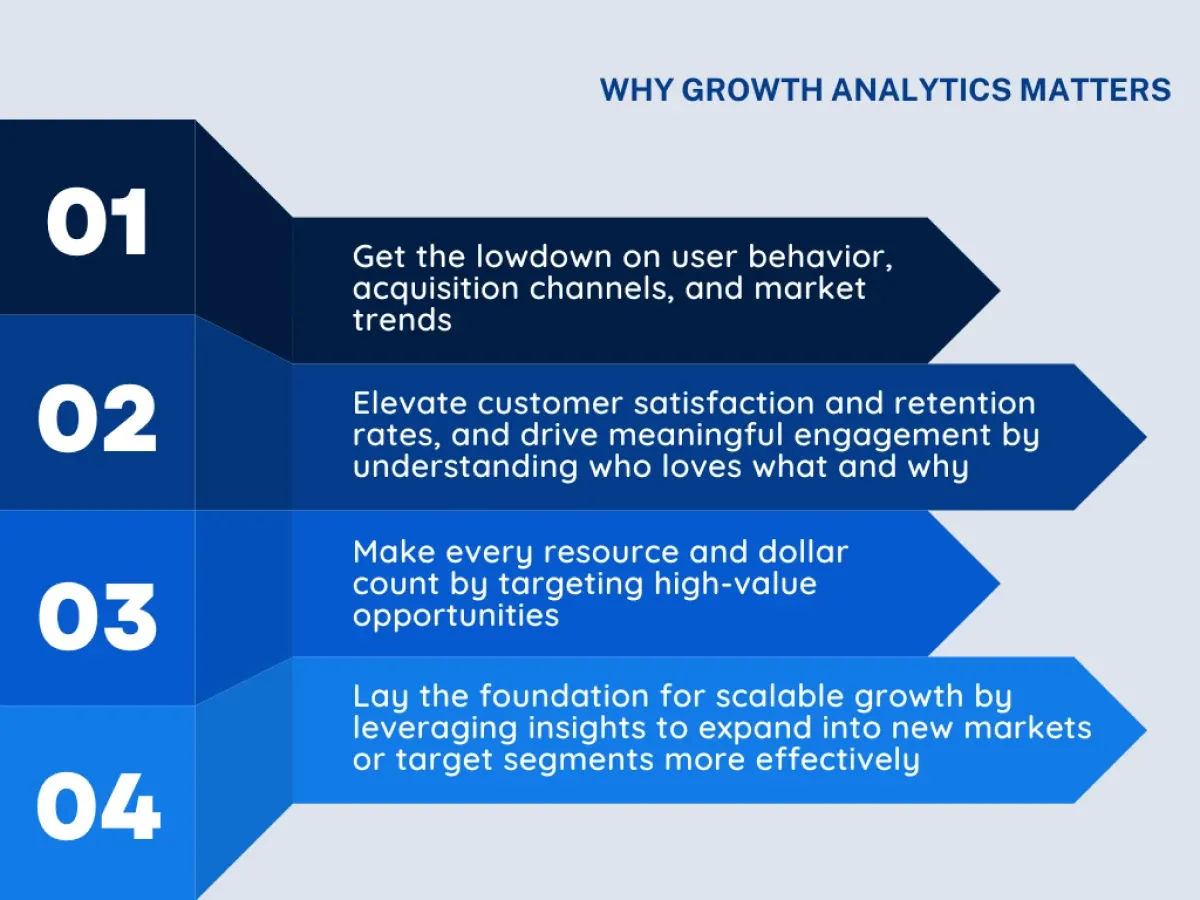If you wish to grow, which way should you go? Growth analytics might just be the answer you need!
Think of growth analytics as the science that helps you to scale your business. Just like any scientific experiment collects evidence and data, analyzes it, and then interprets it to apply to various applications, so does growth analytics. It helps businesses look at how customers and users are being acquired, how readily they are converted, how well they are engaged and how easy it is to retain them.
The impact of embracing growth analytics is undeniable. Companies that embrace growth analytics as part of their strategic planning have been found to consistently achieve a growth of 10–20% in their revenue.
Not only does looking at data help you understand how the customer journey functions, what propels users to activity and why you win some and lose some users, it also helps you build confidence, resilience and agility into your plans when chasing those big business goals.
The pillars of growth analytics – find them, engage with them, keep them
If you’re a B2B SaaS business, you cannot survive unless you understand the three foundational pillars of growth analytics: user acquisition, engagement, and retention.

How exactly do each of these propel your business towards success and what exactly should you be monitoring and analyzing? Let’s find out.
User acquisition
From the very first time a potential user comes your way (or spots you on a billboard in the mall or sees a Google ad) to the time they become a paying customer, the path followed is a twisted, trying one. To understand how much you’re spending on acquiring customers versus how much a customer ends up paying you, here are some key metrics you can consider for your growth analytics plan.
- Lead-to-customer conversion rate: This metric will tell you how many of your leads (those potential opportunities) are turning into paying customers, giving you a clear picture of how effective your sales and marketing efforts are in generating dollars. To calculate it, divide the number of customers acquired by the total number of leads generated in a given time period and multiply it by 100 to get the percentage.
- Customer acquisition cost (CAC): CAC shows you how much it costs to acquire a new customer. It considers all the spending incurred on converting leads into paying customers. To calculate it, divide your total acquisition costs, including what you spent on marketing campaigns or sales initiatives, by the number of new customers acquired within a specific period.
- Customer lifetime value (CLV): Simply bringing a customer on board is not enough for a SaaS business. Knowing how much potential profit that customer can deliver over their lifetime is also important. CLV is the metric that helps you figure this out. To find the CLV, subtract the cost of acquiring and serving the customer from the revenue generated and multiply that by the average customer lifespan.
- Activation rate: Activation rate is crucial for those businesses that run a freemium or trial-based model, as it measures the percentage of users who complete key activation actions. To calculate it, divide the number of users who complete activation actions by the total number of sign-ups and multiply by 100.
- MRR (monthly recurring revenue) growth rate: MRR growth rate shows you how quickly your monthly recurring revenue is increasing. It’s an indicator of the growth trajectory of your subscription business over time. To find out the MRR growth rate, subtract the previous month's MRR from the current month's MRR, divide by the previous month's MRR, and multiply by 100.
- Customer acquisition payback period: This metric tells you how long it takes for the revenue generated from a new customer to cover the cost of acquiring that customer. In other words, if you spent $100 on bagging that new customer, does it take you a day, a month or a year to get that $100 back? It’s the best way to know how effective your customer acquisition efforts are. To calculate it, divide your CAC by your average monthly revenue per customer.
User engagement
Acquiring users is merely the first step in a long (sometimes, a very long) journey towards sustained growth. It doesn’t matter if you’ve got 10,000 customers to brag about if only a small percentage of it is actively using your platform or app.
Here are some metrics you can track as part of your growth analytics plan to understand user interaction patterns and tailor your offerings, campaigns and even messaging to existing as well as potential new users.
- User activity metrics: These metrics measure how actively users are engaging with your SaaS platform and its features. You can calculate it in different timeframes, depending on the kind of insights you need.
- Daily active users (DAU): This represents the number of unique users who interact with your platform on a daily basis. To calculate DAU, count the number of users who engage with your platform within a 24-hour period.
- Weekly active users (WAU): Similar to DAU, WAU is measured on a weekly basis. Calculate WAU by counting the number of unique users who engage with your platform within a 7-day period.
- Monthly active users (MAU): This is the number of unique users who engage with your platform within a calendar month. You can calculate MAU by counting the number of unique users who engage with your platform within a 30-day period.
- Feature adoption metrics: If you wish to understand which features are valued more (or less) by users, feature adoption metrics can be your guiding light.
- Feature adoption rate: The percentage of users who have used a specific feature at least once can be used to figure out a feature’s popularity and relevance. Calculate feature adoption rate by dividing the number of users who have used the feature by the total number of users and multiplying by 100.
- Feature engagement rate: The frequency and depth of user interaction with a specific feature can help you understand how actively users are using a feature. Calculate it by dividing the total number of interactions with the feature by the number of users who have used the feature.
- Session metrics: These metrics quantify user sessions on your SaaS platform.
- Session duration: The average amount of time users spend in a single session on your platform can be an indicator of a user’s interest in the platform’s functionality. Calculate it by summing the duration of all sessions and dividing it by the total number of sessions.
- Session frequency: The average number of sessions per user within a specific time period. Calculate it by dividing the total number of sessions by the number of unique users.
User retention
When it comes to crafting a growth analytics plan for a SaaS business, it's intuitive to prioritize user acquisition and user engagement as core metrics to monitor and analyze. After all, attracting new users and keeping them actively engaged with your platform is what makes or breaks your business model.
User retention metrics, the numbers related to existing customers coming back to your platform, often takes a backseat in growth strategies.
The allure of acquiring new customers is irresistibly seductive. The impact is immediate and tangible. You get praised for every new win. On the other hand, metrics related to user retention emerge more gradually. It is also an undeniable truth that SaaS businesses operate in a cut-throat market – and more often than not, they prioritize near-term growth objectives over long-term retention strategies.
While it may not show an overt connection to traditional growth metrics, retention metrics are very much part of the “growth numbers”. By nurturing existing customer relationships and encouraging repeat business, retention actually drives incremental revenue over time, which means that ultimately you’re making more money from every customer.
Here's a list of retention metrics you can include in your growth analytics plan.
- Churn rate: Churn rate measures the percentage of customers who stop using your product. A high churn rate is a clear indicator of dissatisfaction or disengagement among your customers. To find the churn rate, divide the number of customers who stop using your product during a particular period by the total number of customers at the beginning of the period.
- Retention rate: Retention rate measures the percentage of customers who continue to use your product or service over time (yes, it’s the opposite of churn rate). Just like you want to maintain a low churn rate, your retention rate should be high. Subtract the number of customers who churned during a period from the total number of customers at the beginning of the period, then divide by the total number of customers at the beginning of the period.
Net promoter score (NPS): If you have a genuinely valuable product, your customers would love you and would love to recommend you to others. That’s what an NPS score indicates – how loyal customers are and how likely they are to turn into brand advocates.

Subtract the percentage of detractors (0-6 rating) from the percentage of promoters (9-10 rating) to get the NPS score.
Growth analytics beyond the numbers
While metrics provide valuable insights into the “what” of a growth analytics exercise, it's equally crucial to understand the objectives or the “why” behind it, as well as the process or the “how” of conducting such an exercise.
Setting meaningful objectives is the first step
No growth strategy can begin unless you have clear goals and KPIs (key performance indicators) or metrics defined that match up with your big-picture goals. Why do you want to look at all those numbers? Are you chasing a bigger slice of the pie? Or do you want to just keep your customers happy, now and forever? If you know where you want to go, you can select the right metrics to get the lowdown on how you're doing and help steer your next move.
Segment your users to see them in true light

Not all users are equal and segmentation, whether by firmographics, behavior patterns or acquisition channels, can help you see that. When you look at the granularity, you can uncover gaps, identify untapped opportunities, optimize resources and of course, drive personalized engagement.
Qualitative data unveils feelings
While numbers paint a pretty clear picture of what users are up to and where your business is heading, they miss the subtler shades of the human experience – what does your customer think or feel and why. That's where qualitative data comes in handy. By incorporating user interviews, surveys, and feedback into the analytics mix, you can dive deeper into what makes their users tick – their dreams, their headaches, their big wishes – ultimately informing your product roadmap, sales initiatives and marketing campaigns. Furthermore, you should focus on improving database observability which brings improved CI/CD pipeline performance, agility, consistency, and efficiency. Take a look at the most important database observability metrics examples for DevOps teams to help them get visibility into the state and change of data stores and pipelines.
Be informed by data, propelled by insights
Growth analytics isn't just another “plan” to be executed – it's the cornerstone upon which countless strategies, innovations, and successes are built. It's the compass guiding businesses to spot opportunities, dig deep into product gaps, fine-tune departmental performances, and ultimately, claim a larger slice of the market.

But here's the thing: growth isn't a destination you can just reach where you grab a chair and kick back to relax. It's more like a road trip – a continuous journey marked by vigilant monitoring, daring experimentation, and continuous optimization. Whether you're hustling to bring in more users, striving to keep them engaged, or focused on boosting retention rates, growth analytics is the fuel that keeps your journey moving forward.

















